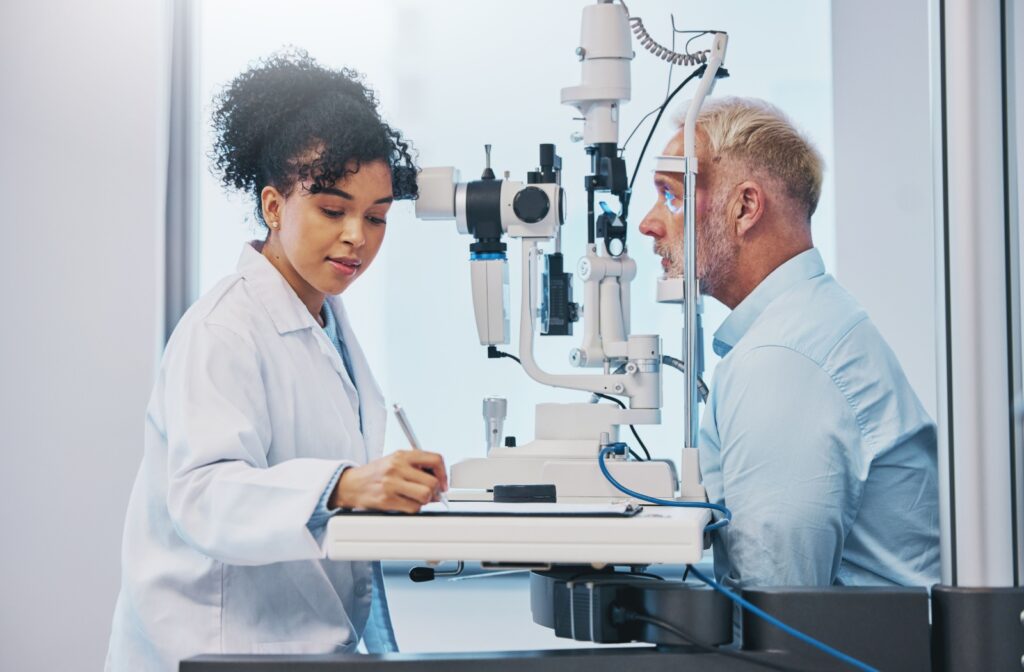Clear vision and ocular health are important for overall well-being and road safety. Vision driving tests at the DMV provide a screening assessment to help confirm that drivers have optimal vision while driving.
During a vision assessment in California, several aspects of vision will be carefully evaluated to confirm individuals meet the necessary standards for safe driving. This includes:
- Visual Acuity
- Peripheral Vision
- Depth Perception
- Color Vision
Importance of a Vision Driving Test
A vision driving test is more than just a formality, it’s a critical component of road safety. Good vision is important for identifying road signs, navigating traffic, and reacting to unexpected obstacles.
Without optimal vision, the risk of accidents increases significantly. The vision driving test helps identify individuals who may need corrective lenses or other interventions to drive safely.
By conducting vision screening tests, the DMV can detect potential vision problems early. This proactive approach allows drivers to address issues before they become severe, allowing them to visit their optometrist for further comprehensive testing.
What Happens During a Vision Driving Assessment in California?
Every state requires a baseline driving vision assessment with some variations during the screenings.
The DMV in California will evaluate different aspects of your vision to confirm you meet the necessary standards for safe driving. This includes:
- Visual Acuity
- Peripheral Vision
- Depth Perception
- Color Vision
California, like other states, requires a minimum visual acuity of 20/40 in at least one eye, with or without corrective lenses to drive. Passing means that an individual can read letters 20 feet away, that a young healthy individual can read 40 feet away.
You can take your vision test while wearing your glasses or contact lenses. However, your driver’s license will include a restriction requiring you to wear your corrective lenses while driving.
Visual Acuity
The visual acuity test measures the clarity or sharpness of your vision. You will look into a vision-testing machine where you’ll see rows of letters or symbols on a screen. These characters will vary in size. You will be asked to read them aloud, from the largest characters to the smaller ones. This assesses how well you can see at different distances.
Adequate visual acuity is crucial for identifying road signs, reading dashboards, and spotting hazards early. This helps you maintain control and make informed decisions while driving.
Peripheral Vision
Peripheral vision assessments check the range of your side vision using a visual field machine.
While looking into the visual field machine, you will be instructed to keep the focus of your vision placed at the center of the screen while holding a button. The focus of your vision cannot move from this center point. When the test begins, lights will appear along the screen. You will be asked to press the button every time you see the light appear on the screen from any point in your field of vision without moving your head.
Peripheral vision is important for monitoring the environment around your vehicle. It allows you to detect vehicles or pedestrians approaching from the sides, conducting safe lane changes, merging, and other driving maneuvers.
Depth Perception
Your depth perception assesses your ability to judge distances accurately.
During the test, you may be shown a pair of lines or objects and asked to identify which is closer or if they are at the same distance. Proper depth perception helps you maintain a safe following distance, park your car correctly, and effectively navigate traffic, reducing the risk of collisions.
Color Vision
This test evaluates your ability to distinguish between different colors. During the test, you may be asked to identify colors on a chart or within certain symbols.
Color vision is important for recognizing traffic lights, signs, and road markings for obeying traffic laws and responding to signals correctly.
Who Is Required to Have a Vision Assessment?
Upon receiving their driver’s license, every driver will have undergone a vision driving test at least once.
A driver may undergo a vision assessment if they’re:
- Applying for a driver’s license for the first time
- Renewing their license at 70 years of age or older
- Randomly selected for a vision screening during the license renewal process
- Reported having a medical condition that may affect their vision
- Required to have a vision re-examination by law enforcement

What Happens If You Don’t Pass Your Vision Driving Test?
If you don’t pass the vision driving test, don’t panic. The DMV typically provides a form called the “Driver Medical Evaluation” (DL 62) to be completed by an optometrist. This form helps determine if your vision can be corrected to meet the necessary standards.
Not passing the vision test at the DMV is a clear signal to visit the eye doctor. An optometrist will conduct a comprehensive eye exam to assess vision and ocular health. If required, the optometrist will prescribe a vision prescription for eyeglasses to help you see clearly while on the road and for any additional visual needs.
Comprehensive eye exams are key for maintaining good vision and eye health. These exams can help detect underlying eye conditions that may manifest without symptoms. Adults between the ages of 19 and 64 are encouraged to have an eye exam every two years, while children 18 and under and adults 65 and older should have an eye exam every year.
Once you’ve visited your optometrist and taken the necessary steps to improve your vision, you can return to the DMV for reassessment. With corrected vision, you’ll likely pass the test and continue driving.
Book an Appointment & Drive Safely!
The vision driving test is an important aspect of maintaining road safety. Routine eye exams can help detect any underlying vision and health concerns before visiting the DMV.
Connect with our team at Total Vision today to schedule your comprehensive eye exam appointment.



